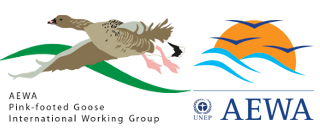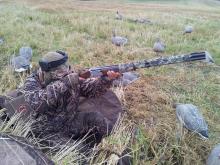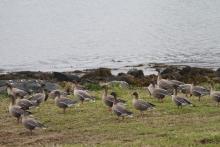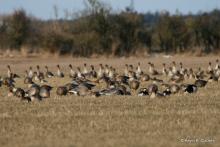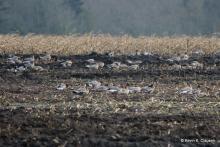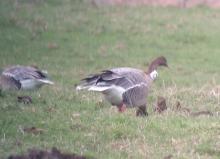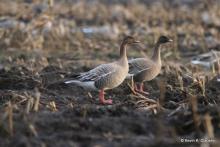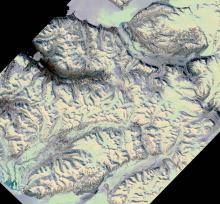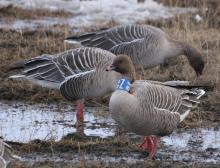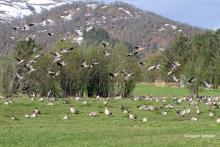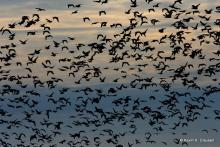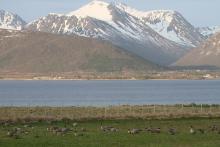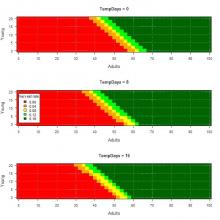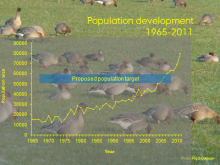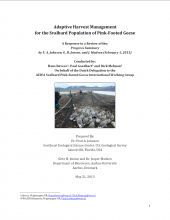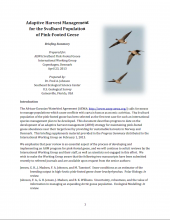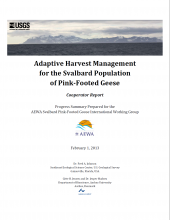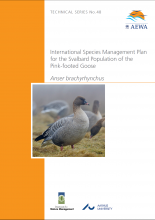Current Size: 76%
Publications
Here you can access a number of papers and articles that have been published to document and support the work of the International Working Group.
* = online academic publication
Soliciting feedback from the International Working Group, scientists and managers as well as peer review of publications are essential aspects of the process to implement the ISMP for the Svalbard pink-footed goose. If you have and comments, queries or require more information about any of these publications please contact the Coordination Unit
Summary
How can the hunting of pink-footed geese be optimised through improved hunting practices and better organisation of hunting at a regional scale?
This question has been addressed in three published papers in the journal Wildlife Biology. They describe the results of experimental field work carried out together with local hunters and landowners in Nord-Trøndelag, Norway, a key autumn staging area for pink-footed geese.
Optimal hunting practices were investigated through hunting experiments carried out in Nesset and Skogn, important staging and hunting areas in Nord-Trøndelag. Researchers worked closely with hunting teams and guided the organization of hunting in the Nesset area and partially controlled hunting in the Skogn area from 2011-2013. The spatial and temporal organization of hunting was experimentally changed between years to represent a range of hunting practices. Responses to different hunting practices were measured by goose abundance and their distribution via daily observations during the hunting season. Additionally, researchers had access to information on hunting date, location, numbers of geese shot and number of shot used, provided by hunting teams.
To provide guidance for the organization of hunting at a regional level, a species distribution model was constructed relating the presence of geese to a range of environmental variables, hypothesised to affect their landscape selection. Established relationships at local area levels where then used to model, predict and identify areas that had a high probability of geese occurring across the entire Nord-Trøndelag region. Furthermore, to determine whether food availability was a limiting factor for goose presence and numbers, the status of fields was classified and density of waste grain was counted on stubble fields before, during and after the geese had left experimental areas.
The experimental hunting study in Nord-Trøndelag has showed that hunters can optimise their practices and hunting organization by:
- Separating hunting events by approximately three days.
- Hunters placing themselves as close as possible to the location of geese flocks observed the day before a hunt.
- Coordinating their hunting with neighbouring hunters, staying approximately three km apart if shooting on the same day.
The species distribution model can be used by hunters to identify areas throughout Nord-Trøndelag with the highest probability of geese occurring and predict the shortest return times by geese in response to hunting events. In this way use of the model by hunters can potentially increase hunting bags.
For all observed years during these studies grain still remained in the fields when the geese had left the study areas. It is concluded that food resources were not a limiting factor at these stopover sites; furthermore, weather conditions (snow) were not limiting goose usage of these sites during the main autumn stopover season. This research suggests that the Nord-Trøndelag area can accommodate more geese than currently observed and could support a higher level of harvest, if hunting is organised in such a way to reduce levels of disturbance.
The research team are grateful to hunters and landowners in Nesset and Skogn for their participation in these research projects and their valuable contribution to the management of the population of pink-footed geese as part of the International Species Management Plan.
These studies are described in three papers published in Wildlife Biology and are available on-line.
Jensen, G.H., Tombre, I.M. & Madsen, J.2016. Environmental factors affecting numbers of pink-footed geese Anser brachyrhynchus utilising an autumn stopover site. Wildlife Biology 22:183-193.
Link
Jensen, G.H., Madsen, J. & Tombre, I.M. 2016. Hunting migratory geese: Is there an optimal practice? Wildlife Biology 22:194-203
Link
Jensen, G.H., Pellisier, L., Tombre, I.M. & Madsen, J. 2016. Landscape selection by migratory geese: implications for hunting organisation. Wildlife Biology, in press.
Link
Summary
Monitoring and assessing the impact of pink-footed geese on arctic tundra vegetation is a fundamental part of the ISMP. A study has been published describing and assessing the extent of arctic tundra degradation on Svalbard, Norway caused by grubbing, where pink-footed geese forage for rhizomes below-ground. The study assessed grubbing extent (occurrence of vegetation disturbance) and intensity (proportion of vegetation disturbed) in 2006/07/08 when goose numbers were approximately 56,000 and in 2013 when they increased to approximately 81,000. Despite a 36% increase in population size, in 2013 the grubbing extent at pre-breeding sites was similar to that in 2007/08 but grubbing intensity was lower. The study suggests that extensive snow cover in 2013 probably dispersed geese over larger areas in search of snow-free patches for feeding, thereby reducing grubbing intensity. Whilst, at the largest known breeding site, both grubbing extent and intensity increased with more geese. Birds preferentially fed close to nests in previously grubbed wet habitat, probably aiding nest defence and permitting feeding on plants that were easier to remove from the soil. The study concluded that a greater impact on tundra vegetation may occur at nesting areas if the breeding population continues to grow. However, timing of snowmelt appears key in moderating the impact of disturbance on tundra vegetation since it controls spatial distributions of feeding geese.
The study is described in a paper published in Écoscience and is available on-line.
Citation: Anderson, H. B., J. D. M. Speed, J. Madsen, Å. Ø. Pedersen, I. M. Tombre and R. van der Wal (2016). "Late snow melt moderates herbivore disturbance of the Arctic tundra." Écoscience 23(1-2): 29-39.
Summary
This paper, published in the journal Wildlife Biology, describes the first results of season length extension on the harvest of the pink-footed goose, which has been selected as the first test case of adaptive harvest management of waterbirds in Europe. In Denmark, the season (previously 1 September to 31 December) was extended to include January in 2014–2015 with the aim to increase the harvest and, in the longer term, reduce the population size. The total harvest in Denmark increased by 52% compared to previous years, and almost 50% of the Danish harvest was taken in the January extension. In this case, the outcomes from the first extension of season suggest that season length adjustment can be an effective tool to regulate harvest, though dependent on winter weather conditions and hunters’ motivation for shooting geese.
The study is described in a paper published in Wildlife Biology and is available on-line.
A PDF copy is attached:
Summary
Scaring is often used as a tool to chase geese away from fields, either as a means to protect vulnerable crops or as part of goose management schemes to drive geese to accommodation areas. Geese are quick to habituate to stationary scaring devices; hence, active scaring by humans is often employed. However, few studies have tested how much effort is required for active scaring to be effective. This paper presents the first study to analyse the relationship between active scaring and consequent effects on goose behaviour and field usage, having applied an experimental dose–response framework.
The study provides guidance to farmers and wildlife managers of goose–agricultural conflicts on the efficiency of active scaring with regard to effective dose and optimal timing of scaring. Its results can also be used in a wider socio-economic evaluation to answer questions of whether scaring is cost-effective for individual farmers and, more widely in terms of planning how active scaring can be used in an integrated management design with ‘go’ and ‘no go’ areas for migrating species.
The study is described in a paper published in the Journal of Applied Ecology and is publically available on-line.
A PDF copy is attached:
Summary
In this study the response of pink-footed geese was analysed to determine the impact of suddenly losing a major autumn staging area along their migration corridor, Filsø in Denmark. This followed the re-establishment of a former lake on open arable land which had served as foraging site to tens of thousands of geese. Comparisons of goose usage before and after the restoration event revealed that (1) approximately 80 % of pink-footed geese abandoned this staging area and (2) formerly site-faithful geese moved to other staging areas along the Danish west coast rather than moving further south to the Netherlands. The study suggests that, at least for pink-footed geese, the cognitive plasticity necessary to alter site use allows a swift response to rapidly changing environmental conditions. This may partly be due to the agricultural habitat use of this species, leaving them plenty of alternatives in the modern Danish landscape.
The study is described in a paper published in the Journal of Ornithology and is available on-line.
A PDF copy is attached:
Summary
This study describes the development in the harvest of the Svalbard Pink-footed Geese in relation to observed changes in population size and migratory behaviour of the population.
In Denmark and Norway the overall hunting bag for pink-feet geese increased stepwise during the 2000s. The population also increased in size over this time but this can only partly explain the change in the hunting bag. It also corresponded to changing patterns in the migratory behaviour of pink-feet, with increased numbers wintering in Denmark and usage of new foraging areas in both Norway and Denmark. This study demonstrates how changes in migratory behaviour and habitat utilisation can abruptly affect exposure to hunting, which showed a functional response to the increased temporal and spatial availability of geese. The paper concludes that the harvest of pink-feet has reached a level likely to cause a population decline. It highlights the need for flexible, internationally coordinated hunting regulations and reliable up-to-date population estimates and hunting bag statistics, to ensure the timely adjustment of management actions.
The study is described in a paper published in PLOSOne and is available on-line.
Part of the data used in this study is available in the Monitoring Data section of this website.
A PDF copy is attached:
Summary
Ringing with plastic neck collars have become a widely used marking technique in waterbird ecology. Neck collars allow researchers to track the life history of individual birds (by continuous re-sightings of marked individuals). Tracking individuals is useful to studies of migration, survival, harvest, behaviour and population size. While it is broadly acknowledged that collar loss can substantially bias the results of these studies by introducing false negatives in the encounter history of individual birds, independent data to estimate retention rate of neck collars are very scarce. As a consequence, neck collar loss is often assumed to be negligible. However, to ensure confidence regarding the outcome of population studies using re-sightings of marked birds, quantitative estimates of collar loss are very important. Based on 23 years of neck collar recovery data from the Svalbard breeding population of Pink-footed Geese, it is estimated that there is an overall average annual loss rate of 3.2%. However, neck collar loss was similar between males and females, and did not (based on currently available data) differ significantly between two types of collars used.
The study is described in an article published in BTO Bird Study and is available on-line.
A PDF copy is attached:
Summary
A study, using a long-term mark-resighting dataset and scoring of body condition, for the Svalbard-breeding population of pink-footed geese has demonstrate a substantial effect of winter harshness on post-winter body condition. However, this effect was compensated along the spring migration corridor, and did not persist long enough to influence future reproduction. This highlights the importance of temporal scale when assessing impacts of environmental effects, and suggests a state-dependent physiological mechanism adjusting energy accumulation according to internal energy stores carried into spring. In support of these findings, the development of body condition was unaffected by whether geese used supplementary feeding sites or not. While there was no effect of winter harshness on the average population pre-breeding body condition, individual variations in early spring body condition (probably related to different life-histories) were partly traceable throughout spring. This strongly indicates a carry-over effect on the individual level, possibly related to differences in dominance, site use, disturbance or migration strategy, which may potentially affect future reproduction.
The study is described in an article published in PlosOne and is available on-line.
A PDF copy is attached:
Summary
On Svalbard pink-footed geese nest in two contrasting but commonly found habitats: steep cliffs and open tundra slopes. A study was undertaken to compare nest densities and nesting success in these two environments, over ten breeding seasons, to assess the impact of spring snow cover, food availability for nesting adults and arctic fox abundance (as the main terrestrial predator).
In years with extensive spring snow cover, fewer geese at both colonies attempted to breed, possibly because snow cover limited pre-nesting feeding opportunities, leaving adults in poor breeding condition. Nesting success at the steep cliff colony was lower with extensive spring snow cover; such conditions force birds to commit to repeated and prolonged recess periods at far distant feeding areas, leaving nests open to predation. By contrast, nesting success at the open tundra slope was not affected by spring snow cover; even if birds were apparently in poor condition they could feed immediately adjacent to their nests and defend them from predators. Foxes were the main nest predator in the open tundra slopes but avian predators likely had a larger impact at the steep cliffs colony. Thus, the relative inaccessibility of the cliffs habitat may bring protection from foxes but also deprives geese from readily accessing feeding areas, with the best prospects for successful nesting in low spring snow cover years. The findings of this study indicate that spring snow cover, predator abundance and food proximity did not uniformly influence nesting success of this herbivore, and their effects were dependent on nesting habitat choice.
The study is described in an article published in Polar Biology and is available on-line.
A PDF copy is attached:
Summary
Ringing and marking are widely used techniques in avian ecology to assist studies of migration, survival and behaviour, and often used to estimate population sizes. However, only rarely, are the effects of these markings on birds thoroughly tested. Using an abdominal profile index of marked geese and body mass of recaptured birds previously marked, this study investigated the effect of neckbands on body condition of Pink-footed Geese Anser brachyrhynchus to evaluate to what extent capture, handling and banding affected these birds on short, medium and longer terms
Its results indicated that body condition of geese were negatively affected in the days immediately succeeding capture, but that only a minor effect persisted on a seasonal scale. The study found no support for a long-term effect of neckbands on the body mass of individual birds and the long-term effects are expected to be minor. Nevertheless the capture and handling event might be the cause of a temporary decline in body condition. In addition, neckbands might still influence important life-history traits such as reproduction and survival by means of, e.g., altering social interactions, increasing predation or interfering with mate acquisition.
The study is described in an article published in the Journal of Ornithology and is available on-line.
A PDF copy is attached:
Summary
In 2006 a regional subsidy scheme was introduced in Nord-Trøndelag, central Norway to allow pink-footed geese to forage on pasture and arable lands during their stop-over stays whilst on spring migration. In previous years intensive feeding on pastures and newly sown cereal fields were the cause of escalating conflicts with farmers. To aid the identification of fields most susceptible to goose grazing a system was developed for ranking all fields in the region according to their suitability for pink-footed geese. This ecologically based tool was used by the regional authorities, from 2009 onwards, as the basis for prioritizing and allocating subsidies to farmers to create areas to accommodate the geese (refuge areas).
In 2010 field research was conducted to evaluate the efficiency of this prioritization, in terms of how subsidies were actually used. This article presents the results, confirming that the ecologically based prioritization tool resulted in a high efficiency of funds allocated for subsidies; effectively creating refuge areas. The article also concludes that close dialogue between scientists and managers was one of the keys to the success of the scheme and its development. Furthermore it is recognised that the prioritization tool and the subsidy scheme will need continuing adjustments, as well as user collaborations, as goose populations continue to grow and to account for an adaptive dual strategy to attract geese to certain fields whilst also scaring them from others. The article is published online with open-access in AMBIO.
For more details please see the attached report:
Summary
This article details a study to investigate the demographic connectivity between the eastern and western flyway populations of pink-footed geese, based on resightings of marked geese from both populations. Previous genetic analyses suggested a modest gene flow between the two populations. This latest analysis reiterated that the two populations currently appear to be demographically closed. The article concluded that, current initiatives to internationally manage the eastern population of pink-footed geese do not need to consider net immigration in predictive harvest models. Furthermore it stated, for waterbirds in general, a targeted approach to evaluate connectivity, using classic marking studies in combination with molecular methods and focussed sampling on breeding grounds, is recommended to better underpin management decisions at population levels.
The article is available on the Wily Online Library as an open-access publication.
For more details please see the attached report:
Summary
As the population of the Svalbard pink-footed goose has increased considerably over the last few decades conflicts with farmers have escalated, especially at stopover sites in spring in North Norway. This article presents results from a multidisciplinary study of a negotiation process between farmers and wildlife authorities, which led to an agricultural subsidy scheme to alleviate conflicts between agriculture and geese in the Vesterålen region. The efficiency of the subsidy scheme was assessed in terms of its conflict mitigation, reflected in a near discontinuation of scaring activities. For the farmers, the subsidy scheme provides funding that reduces the economic costs caused by the pink-footed geese, but the situation has been complicated by the increasing occurrence of another goose species, the barnacle goose. The article concludes that ‘sustaining a low level of conflict will require close monitoring, dialogue and adaptation of the subsidy scheme to cater for changes in goose population dynamics’. The article is published on the open-access publication website, PLOSone.
For more details please see the attached report:
Summary
This article explores and evaluates the uncertainties associated with the population dynamics and predictive models developed for the pink-footed goose, and how these influence the selection of an optimal harvest strategy for the Svalbard population. In addition, it outlines the gain in management performance (i.e. maintaining a stable population at the desired population size) that could be expected if uncertainty could be eliminated or reduced, and whether an adaptive or robust management strategy might be most appropriate in the face of uncertainty. An adaptive strategy being one where the credibility of the models are periodically revised, whilst a robust strategy is where no learning is anticipated.
The article also emphasises that the implementation of any informed strategy, either adaptive or robust requires an adequate monitoring program. Continuing a ground census count that provides estimates of population size and proportion of young is regard as essential, preferably post-harvest during spring migration (after the impact of any management actions). In addition, for relatively long-lived species like the pink-footed goose, eliminating uncertainty about survival rates used in predictive models provide the greatest gain in management performance. Furthermore, it is noted that any age dependency in survival also has important implications for how populations respond to harvest. Concerted efforts are recommended to re-assess current rates of survival and acquire either estimates of realized total harvest rates or the age composition of the harvest.
For further insights this article is published as an open-access article in Ecological Modelling and is available on-line through Science Direct / Elsevier.
A PDF copy is attached below:
Summary
The setting of population targets is a much debated subject, particularly when talking about population control. One of the objectives of the International Species Management Plan (ISMP) for the Svalbard pink-footed goose is to stabilise the population. In order to realise this objective it was necessary to set a population target to aim for. This was a new approach for waterbird management in Europe and little was known about setting or gaining agreement on such a population target. To help understand some of the issues and different stakeholder perspectives research was undertaken amongst a number of key decision makers. The article presents the results from this study and it is published on the open-access publication website, PLOSone.
For more details please see the attached report:
Summary
A study has used snow conditions in Svalbard to predict the breeding success of the pink-footed goose. The authors predict that with a climate-induced decrease in snow cover in Svalbard, the population of pink-footed geese will increase its growth, at least in the short term. In addition, this study is important in helping to predict the annual harvest and evaluate the optimal harvest strategy to ensure the population is maintain in a stable state and in favourable conservation status.
The study built upon local observations that showed that snow cover influenced breeding success of pink-footed geese. It up-scaled the analysis to the whole Svalbard population by examining various measures of snow conditions and compared them with the overall breeding success of the population, based on the proportion of juveniles in the autumn population counts. The results indicate that the breeding potential of the population may have been released, due to the recent advancement of spring in Svalbard and reproduction not being constrained by snow cover in the early part acheter cialis 20mg of the breeding season.
The study is described in an article published in Polar Biology and is available on-line.
A PDF copy is attached below:
Summary
This document was written in response to the Dutch review of the AHM Cooperator Report: Progress Summary. It provides excerpts of the reviewers’ comments and responses from the authors. Peer review of this document was considered important and the authors expressed their sincere appreciation to the reviewers for their very thorough and constructive review of the Progress Summary.
For more details please see the attached report:
Summary
At the request of the Dutch Ministry of Economic Affairs a review was undertaken of the AHM Cooperator Report: Progress Summary. It was carried out by several prominent scientists from Wageningen University, Netherlands. Their findings, comments and discussion were submitted to the Coordination Unit and Dr. Fred A. Johnson, of the U.S. Geographical Survey who subsequently responded.
For more details please see the attached report:
Summary
This document describes the work subsequently undertaken by Dr. Fred A. Johnson, of the U.S. Geographical Survey, after distribution of the AHM Cooperator Report: Progress Summary. This work focused on better understanding the implications of model uncertainty and on developing an optimal strategy for setting harvest quotas that would remain in effect for three years.
For more details please see the attached report:
Summary
This document describes the initial work undertaken by Dr. Fred A. Johnson, of the U.S. Geographical Survey, in developing a number of alternative population models used to determine a potential harvest management strategy for the Svalbard Pink-footed Goose. It is recognised that continued development of the population models are part of the on-going process of implementing an Adaptive Harvest Management Strategy for Svalbard Pink-footed Goose. Consequently this work was subsequently further refined by Dr. Johnson and is described in the Adaptive Harvest Management Briefing Summary.
For more details please see the attached report:
Summary
This AEWA document (Technical Series No. 48) set outs the goal, objectives and a framework for action for the International Species Management Plan (ISMP) for the Svalbard population of the pink-footed goose. It also provides background information on the population with a biological assessment along with threat and management analyses highlighting potential issues. The ISMP was adopted at the 5th session of the AEWA Meeting of the Parties in May 2012, in France.
For more details please see the attached report.
The work of both the International Working Group and the Coordination Unit are guided by Terms of Reference which were adopted at the Implementation Meeting of the AEWA International Species Management Plan (ISMP) for the Svalbard population of the Pink-footed Goose, which took place in August 2012 in Longyearbyen, Svalbard.
For more details please see the attached documents.
For full picture details, please visit the credits page.
